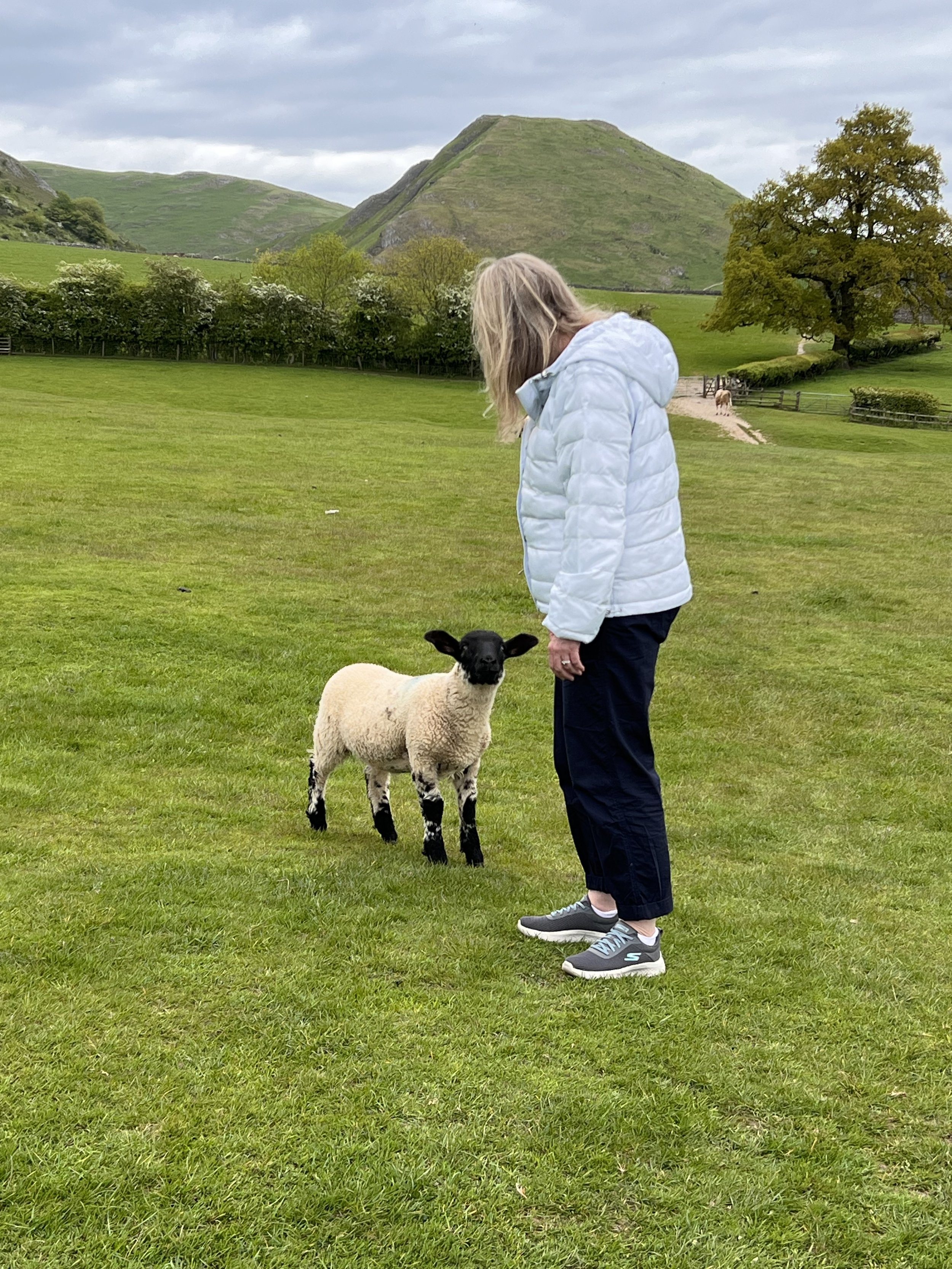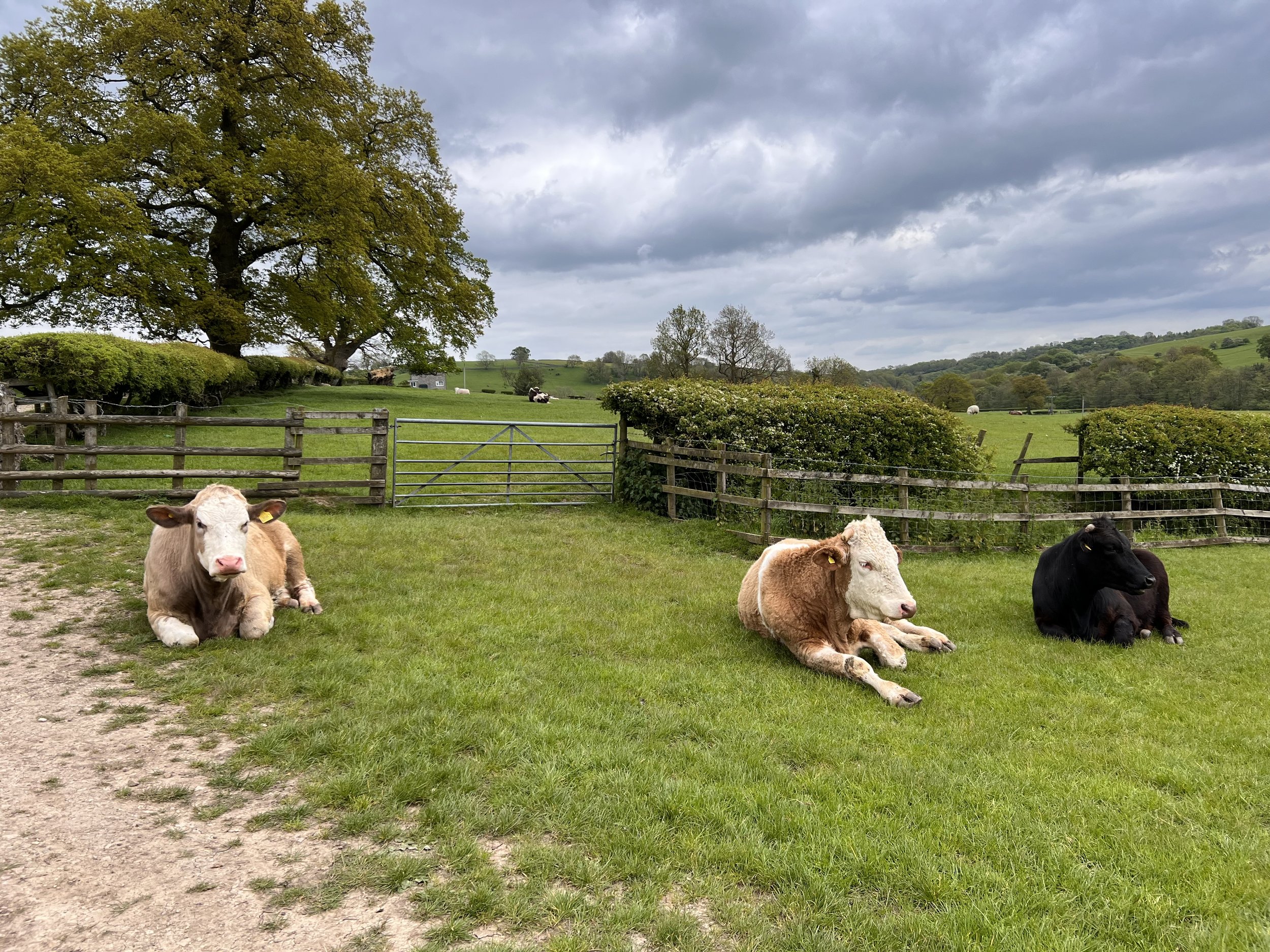At Our Peak
“Think only of the past as its remembrance gives you pleasure.”
Dovedale
The verdant valley carved by the River Dove is England’s Eden. On Wednesday (May 17), 14 years on, we retraced our path from 2009 over the famous Stepping Stones.
Amanda makes her way across the River Dove in 2009.
2023
2023
The River Dove
Walking the public footpath from the Dovedale car park to the Manifold Tea Room in the nearby village of Ilam (Eye-Lam).
Without realizing it, we took this photo in nearly the same place as a photo from 2009.
During our 2009 trip, we rented bicycles from the Ashbourne Bike Hire, and road along the Tissington Trail (an old railroad line converted to a foot and bicycle path), before taking roads over to the Dovedale valley. If I recall, it was a bit of a longer haul than we anticipated. 😅
There are 26,000 miles of dry stone wall in the Peak District—equivalent to a complete wall around the Earth.
The unusual looking peak is Thorpe Cloud.
We were met by some curious locals.
On our way back…total apathy!
Our purpose in walking to Ilam was to fix our greatest faux pas while in England. (It wasn’t on the scale of ordering a Black and Tan in Ireland (twice!), but embarrassing nonetheless.)
You see, this is Manifold Tea Room (named after River Manifold just below the house) in 2009—the first tea room we ever visited in the Land of Tea.
In honor of the classic English nursery rhyme: See Tweedledum and Tweedledee go the counter and order tea. Let’s see, they don’t have any Lipton…so…
Oh, I know, let’s order a pot of raspberry tea! We can’t believe they didn’t kick us out right then and there! It’s almost like it was a trap. 🤔
The English are too polite, but had we been in Ireland they would said (probably under their breath like the bartender at Temple Bar)—Feckin’ Gobshite!
So Wednesday was the day to set things in order by going back and ordering a proper cup of tea. Did we check the Googles before we left to ensure the tea room was open? You betcha! Was it open when we arrived? Absolutely not! The café next door was open, but the Manifold Tea Room was set to open the very next day. 🤬 (…to be continued…)
Grindleford Station Circular
On Thursday (May 18) we decided to go for a long walk. The trail began at the Grindleford Train Station, entering the ancient woodland through the lovely Padley Gorge. Here we are on a footbridge crossing Burbage Brook.
A really cool stone wall stile, with the Toad’s Mouth rock behind. From here, the route headed out over Hathersage.
We passed Over Owler Tor (not seen behind me) and onward to Millstone Edge.
Looking over Millstone Edge.
Quite possibly the best views in the whole of the Hope Valley are from Millstone Edge.
Old carved millstones dot the hillsides.
Nearing the end of our 4.5 mile loop.
Buxton
On Friday (May 19) we went to the spa town of Buxton to do a little browsing and see the town that we had wanted to explore back 2009 but ran short on time to visit.
While Amanda checked out the many charity shops, I walked down to the locally famous Scrivener’s Books and Bookbinding.
If you’re wondering about the five floors, there is an attic you can make out in the picture above this one, and a cellar.
Cool tree carving in the middle of the massive Buxton Park.
While under the custodianship of George Talbot, Earl of Shrewsbury, Mary Queen of Scots stayed here to take the waters on numerous occasions between 1573 and 1584.
The center of Buxton is dominated by the large hill-park known as The Slopes.
Buxton's renowned thermal mineral water fell as rain over 5,000 years ago. As the water passes through the Derbyshire limestone, it is purified slowly, mineralized consistently, and heated naturally.
Residents and visitors have been drinking, bathing in, and collecting this precious water for centuries. The water from this well is the same bottled under the Buxton brand and emerges from the ground at a constant 81.5° F.
When the Romans arrived in around 70 AD, the springs were already a sacred site. Like the Celtic Britons, the Romans believed the warm waters had special powers and built a settlement and baths around them.
In medieval times, the use of water for healing was associated with St Ann. The well became a shrine to her and sick pilgrims flocked to Buxton hoping for a miraculous cure.
Mary, Queen of Scots, visited several times between 1573 and 1584 in search of a cure for her rheumatism.
In the 1770s, William Cavendish (5th Duke of Devonshire and owner of the Chatsworth estate) moved the location of the well and began building nearby. His aim was to create a fashionable spa town to rival Bath. Its centrepiece was the Crescent, completed in 1789.
Buxton's reputation as a spa resort grew and the arrival of the railway in 1863 opened it up to a wide range of visitors, who stayed in its new boarding houses and hydro hotels.
The 8th Duke of Devonshire built The Pump Room (above) to provide a fashionable and elegant place to enjoy Buxton's famous water in comfort. Once a water source was discovered that did not require a pump, the Pump Room was obsolete and renamed St Ann's Well.
Such a beautiful day, it’s hard to believe that in about 15 minutes after taking this picture, the sky opened and flooded the streets with rain. ☔️
No worries…we had just sat down inside the Café at Green Pavilion ready to enjoy hot beverages! 😉
Heights of Abraham
The Heights gets its name from a historic battle fought on the Plains of Abraham in Quebec in 1759, that led to a brief period of British supremacy in North America.
On the gondola to the peak.
The town of Matlock Bath and the River Derwent below.
Ever since Roman times, the land on Masson Hill has been used by miners hoping to earn a living by extracting lead from the hillside.
The Great Rutland and Great Masson Caverns were transformed from working lead mines to tourist attractions in the early part of the 19th century.
Notations made by miners in 1705.
Back on the surface at Tinker's Mine Shaft viewpoint.
When we emerged from the cavern, Amanda heard a mother rebuking her children in the way only an Englishwoman can, “You were both so lovely in there, and now that we are outside, you’ve gone absolutely feral”! Hilarious!
Queen (then Princess) Victoria travelled by donkey to the top of the Heights in the early 1830s. A few years later, recently redundant lead miners were retained through the winter to build the Prospect Tower in her honor. This is the view from the top of the tower.
Heading back down.
From the bottom we spotted these parachutists.
An old Morris in the car park.
During our week-long stay in the Peak District back in 2009, we stayed at Pendleton Cottage, which is the building behind us. The solar panels are new, as is the two-tone building to the right. Back then the driveway was gravel.
2023
2009
And Now the Dramatic Conclusion to:
The Manifold Drama
Third time was the charm! On Saturday (May 20), on our final day in the Peak District, we made it to the open Manifold Tea Room and finally righted our last wrong (we also visited Eyam, which we had missed in 2009)!
Two proper cuppas!
Strong black tea steeped in a tea pot with steaming-hot water, Demerara sugar, and a wee bit of oat milk. 😌
Add in two vegan chocolate chip cookies and a fruit scone, and we’re all set!
Foot bridge over River Manifold.
Our return visit to the Peak District did not disappoint. With so many famous estates and so much beauty, all packed into such a small region—you simply cannot go wrong here. Thank you Peak District for delivering another trip full of great memories; we are grateful! Tomorrow it’s off to York!
Before you go, here is the video tour of our Peak District apartment we promised—enjoy!
The birds were singing during our Hunter’s End Apartment video tour: https://www.youtube.com/watch?v=WQ0CH5rLfwY




























































